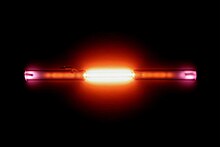Our website is made possible by displaying online advertisements to our visitors.
Please consider supporting us by disabling your ad blocker.
Helium
 | |||||||||||||||||||||
| Helium | |||||||||||||||||||||
|---|---|---|---|---|---|---|---|---|---|---|---|---|---|---|---|---|---|---|---|---|---|
| Pronunciation | /ˈhiːliəm/ | ||||||||||||||||||||
| Appearance | colorless gas, exhibiting a red-orange glow when placed in an electric field | ||||||||||||||||||||
| Standard atomic weight Ar°(He) | |||||||||||||||||||||
| 4.002602(2)[1] | |||||||||||||||||||||
| Helium in the periodic table | |||||||||||||||||||||
| |||||||||||||||||||||
| Group | group 18 (noble gases) | ||||||||||||||||||||
| Period | period 1 | ||||||||||||||||||||
| Block | s-block | ||||||||||||||||||||
| Electron configuration | 1s2 | ||||||||||||||||||||
| Electrons per shell | 2 | ||||||||||||||||||||
| Physical properties | |||||||||||||||||||||
| Phase at STP | gas | ||||||||||||||||||||
| Melting point | 0.95 K (−272.20 °C, −457.96 °F) (at 2.5 MPa) | ||||||||||||||||||||
| Boiling point | 4.222 K (−268.928 °C, −452.070 °F) | ||||||||||||||||||||
| Density (at STP) | 0.1786 g/L | ||||||||||||||||||||
| when liquid (at m.p.) | 0.145 g/cm3 | ||||||||||||||||||||
| when liquid (at b.p.) | 0.125 g/cm3 | ||||||||||||||||||||
| Triple point | 2.177 K, 5.043 kPa | ||||||||||||||||||||
| Critical point | 5.1953 K, 0.22746 MPa | ||||||||||||||||||||
| Heat of fusion | 0.0138 kJ/mol | ||||||||||||||||||||
| Heat of vaporization | 0.0829 kJ/mol | ||||||||||||||||||||
| Molar heat capacity | 20.78 J/(mol·K)[2] | ||||||||||||||||||||
Vapor pressure (defined by ITS-90)
| |||||||||||||||||||||
| Atomic properties | |||||||||||||||||||||
| Oxidation states | 0 | ||||||||||||||||||||
| Electronegativity | Pauling scale: no data | ||||||||||||||||||||
| Ionization energies |
| ||||||||||||||||||||
| Covalent radius | 28 pm | ||||||||||||||||||||
| Van der Waals radius | 140 pm | ||||||||||||||||||||
| Other properties | |||||||||||||||||||||
| Natural occurrence | primordial | ||||||||||||||||||||
| Crystal structure | hexagonal close-packed (hcp) | ||||||||||||||||||||
| Speed of sound | 972 m/s | ||||||||||||||||||||
| Thermal conductivity | 0.1513 W/(m⋅K) | ||||||||||||||||||||
| Magnetic ordering | diamagnetic[3] | ||||||||||||||||||||
| Molar magnetic susceptibility | −1.88·10−6 cm3/mol (298 K)[4] | ||||||||||||||||||||
| CAS Number | 7440-59-7 | ||||||||||||||||||||
| History | |||||||||||||||||||||
| Naming | after Helios, Greek Titan of the Sun | ||||||||||||||||||||
| Discovery | Pierre Janssen, Norman Lockyer (1868) | ||||||||||||||||||||
| First isolation | William Ramsay, Per Teodor Cleve, Abraham Langlet (1895) | ||||||||||||||||||||
| Isotopes of helium | |||||||||||||||||||||
| |||||||||||||||||||||
This page or section needs to be cleaned up. The specific problem is: The atomic number went glitch and cannot be fixed. (July 2024) |

Helium is a chemical element. It has the chemical symbol He, atomic number 2, and atomic weight of about 4.002602. There are 9 isotopes of helium, only two of which are stable. These are 3He and 4He. 4He is by far the most common isotope.
Helium is called a noble gas, because it does not regularly mix with other chemicals and form new compounds. It has the lowest boiling point of all the elements. It is the second most common element in the universe, after hydrogen, and has no color or smell. However, helium has a red-orange glow when placed in an electric field. Helium does not usually react with anything else. Astronomers detected the presence of helium in 1868, when its spectrum was identified in light from the Sun.[6] This was before its discovery on Earth.
Helium is used to fill balloons and airships because its density is lighter than air. It does not burn, so is safe for that kind of use. It is also used in some kinds of light bulbs. People can breathe in helium: It makes their voices sound higher than it normally does. This may seem silly, but it can actually be quite dangerous as if they breathe in too much, hypoxia can injure or kill them as they are not breathing normal air. Breathing too much helium can also cause long-term effects to vocal cords.
Helium is created through the process of nuclear fusion in the Sun, and in similar stars. During this process, four hydrogen atoms are fused together to form one helium atom. On Earth it is made by the natural radioactive decay of heavy radioactive elements like thorium and uranium, although there are other examples. The alpha particles emitted by such decays consist of helium-4 nuclei.
- ↑ "Standard Atomic Weights: Helium". CIAAW. 1983.
- ↑ Shuen-Chen Hwang, Robert D. Lein, Daniel A. Morgan (2005). "Noble Gases". Kirk Othmer Encyclopedia of Chemical Technology. Wiley. pp. 343–383. doi:10.1002/0471238961.0701190508230114.a01.
- ↑ Magnetic susceptibility of the elements and inorganic compounds, in Handbook of Chemistry and Physics 81st edition, CRC press.
- ↑ Weast, Robert (1984). CRC, Handbook of Chemistry and Physics. Boca Raton, Florida: Chemical Rubber Company Publishing. pp. E110. ISBN 0-8493-0464-4.
- ↑ Kondev, F. G.; Wang, M.; Huang, W. J.; Naimi, S.; Audi, G. (2021). "The NUBASE2020 evaluation of nuclear properties" (PDF). Chinese Physics C. 45 (3): 030001. doi:10.1088/1674-1137/abddae.
- ↑ Based on this location, its name was derived from the Greek word for Sun, helios.
Previous Page Next Page



